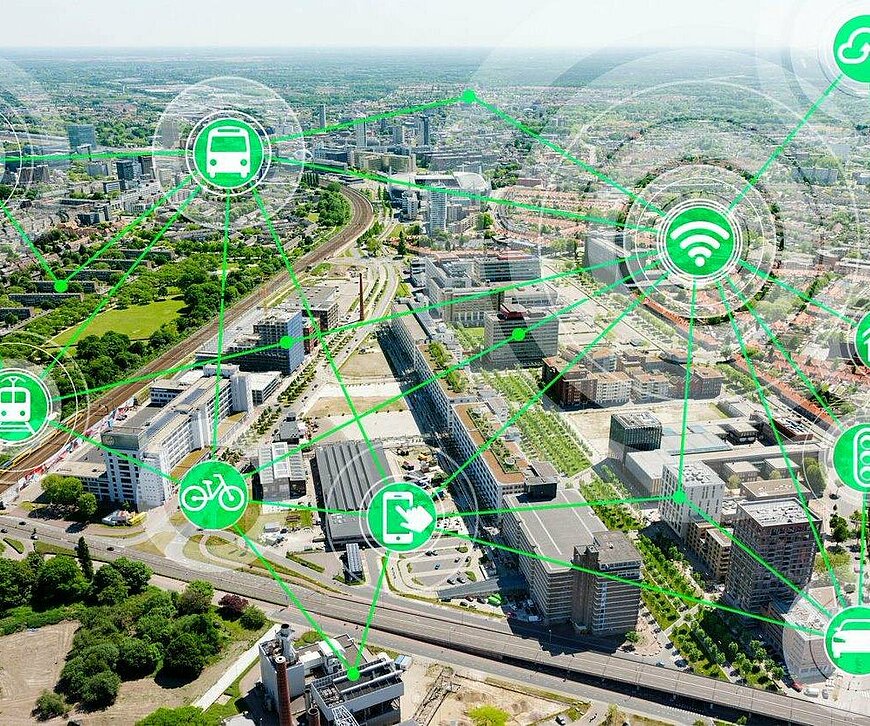Managing the mobility of the future requires collaboration

Clear views on managing the mobility of the future are needed to reach the right innovations in traffic management. As logical as this may seem, panel host Peter Morsink (Royal HaskoningDHV, SmartwayZ.NL) helped his audience at the Automotive Campus with a sharp definition at the start of the debate on traffic management. “It’s about purposely influencing road usage to optimize traffic flows based on policy. This means giving the right information at the right moment to road users, guiding and directing them when necessary.” The goal is clear, Morsink says: “Good traffic management will help to effectively use the capacity of the road network, increase the liveability of our cities and improve road safety.”
This article is written by Innovation Origins as part of a series about the Automotive Week 2023 that took place from April 16th to 19th at the Automotive Campus in Helmond.
But obviously, this also brings challenges. Roads get busier, lots of new technology is popping up, and stakeholders don’t always follow the same paths. Morsink: “Technology can leverage the achievements of road operators, service providers, and the automotive industry. That’s how we can manage the mobility of the future.”
Participants:
Etienne Wieme (Projectmanager C-ITS/Smart Mobility, Province of North Brabant, SmartwayZ.NL)
Yvonne van Velthoven – Aarts (senior advisor Traffic Management & Innovation City of Eindhoven)
Rodrigue Al Fahel (Project Manager, Lindholmen Science Park)
Bob Randsdorp (Director Business Development Smart Mobility, Royal HaskoningDHV)
Stephanie Leonard (Head of Government and Regulatory Affairs, TomTom)
Representatives from almost all stakeholders in traffic management were gathered in the panel, each showing a willingness to find and build potential solutions collectively. Still, their differences in focus also became apparent. For Etienne Wieme, innovative traffic management requires a self-steering system, well-informed users and in-app cooperation.
“There’s a transition going on; technology is taking over tasks from drivers and traffic managers. This helps us in monitoring all modes of transport and roads, influencing speeds and road choices, predicting traffic, offering intelligent access, and facilitating automated vehicles.”
Etienne Wieme

Fewer cars
Yvonne van Velthoven started with a warning for everybody in ‘her’ city of Eindhoven: “Towards 2040, we want to build a greener city, with less cars. But at the same time, there’s a densification of the city going on, with around 40,000 extra homes. That all means that for the next decades, a lot of construction will be needed. And construction means roadworks. All deviations, in consequence, will need to be organized through a combination of communicative actions. Think of information on our websites, variable message signs above the road, and cooperation with service providers of navigation systems. Every development raises new expectations. It’s a complex situation but also one full of opportunities.”
Communication was also at the heart of Rodrigue Al Fahel’s message. Based on his experience in Gothenburg (Sweden), he explained that geofencing is a perfect way of guiding your information to the right people at the right moment. “We need to focus on building solutions that can give people a voice, clarity, and understanding. With geofencing, you can offer two-way communication, which is crucial in reaching your goals.” Five steps are needed to turn geofencing into a promising community tool, he adds. “First of all, the available information must be bounded to a geographic area, which is a role for the industry.
Then, the communication from the sender to the receiver must be adequate. This can of course only work well if the receiver has shared their geographical location. The fourth step is that the receiver acts on the information. Finally, the receiver must send feedback to the road authority or the service provider. "
"My advice to all stakeholders would be not to focus on the best system but on creating the best communication loop.”
Rodrigue Al Fahel

Communication is also one of the key elements in Bob Randsdorp’s pitch. “In fact, if communication works right, the problem creators can also help solve the problem.” In other words: traffic is the problem, but if analyzed correctly, it can also offer the data needed for a solution. “At Royal Haskoning, we help to manage today’s and tomorrow’s mobility by implementing policy and our knowledge into software.” One of the ways to achieve the goals is by connected traffic management, he adds.
"Connecting information services, data brokers, and intelligent traffic light installations is supporting the accessibility and liveability of the mobility system.
Bob Randsdorp
The need for collaboration
For TomTom, it has become clear that navigation services have become so complex that it’s not possible anymore for one single company to offer a complete service. That’s also the reason behind the Overture Maps Foundation initiative, in which TomTom works together with Microsoft, Amazon, and Meta. “And in the future, with potential new partners”, Stephanie Leonard says. “Not only maps are developing from Standard Definition via ADAS to High Definition, but also do we have to take the evolution of driving itself into account. Traffic management with highly automated vehicles requires new solutions in de control centre, but also in the way we deliver the service to the users. Going from human control, via mixed ways of assistance to fully autonomous leads to a demanding situation for all stakeholders.” In the future situation, it’s about instructing drivers outside and inside the car, monitoring the vehicles and the drivers, and about complete vehicle systems in which the car is connected to a multitude of other actors. “That’s why we need collaboration to handle the evolution of traffic.”
Because of the diversity of challenges, the panel expects that professional traffic - think of truck and coach drivers - is a logical first target group. Also, the main goals expressed by SmartwayZ.NL are considered an important precondition: “Improve the accessibility of the region and further develop the mobility system by innovation, to make this system future-proof.”
